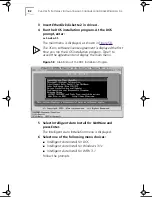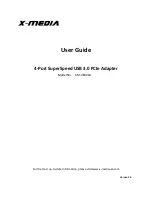
90
C
HAPTER
5: S
OFTWARE
I
NSTALLATION
AND
C
ONFIGURATION
U
NDER
W
INDOWS
3.
X
Changing Configuration Settings
The NIC Configuration screen (
Figure 59
on
page 86
)
shows the current configuration settings for the installed
NIC. You can change the default settings to:
■
Disable Plug and Play
■
Use a boot PROM
■
Optimize driver performance for a specific
operating system
■
Optimize driver performance for operation on a server
■
Change the type of network connector
Table 8
lists each software option, the default setting for
that option, and other available settings for that option. For
more information about an option, select the option and
press F1.
.
Table 8
NIC Option Settings
Option
Default Setting
Supported Settings
I/O Base Address
300h
200h, 210h, 220h, 230h, 240h, 250h,
260h, 270h, 280h, 290h, 2A0h, 2B0h,
2C0h, 2D0h, 2E0h, 2F0h, 300h, 310h,
320h, 330h, 340h, 350h, 360h, 370h,
380h, 390h, 3A0h, 3B0h, 3C0h, 3D0h,
3E0h, EISA, ISA
Interrupt Request
Level
10
3, 5, 7, 9, 10, 11, 12, 15
Boot PROM
Disabled. Does
not apply for
3C509B-TPO.
Disabled, 8K, 16K, 32K
Transceiver Type
Auto Select for all
except 3C509B-TPO
(on-board TP)
On-board Coax (BNC), On-board TP
(RJ-45), External (AUI/DIX), or Auto Select
Network Driver
Optimization
Windows or
OS/2 Client
DOS Client, Windows or OS/2
Client, Server
Maximum
Modem Speed
(fastest modem
installed)
9600 Baud
No Modem, 1200, 2400, 9600, 19200,
or 38400 Baud
Plug and Play
Enabled
Enabled, Disabled
Full-Duplex
Disabled
Enabled, Disabled
Book Page 90 Monday, June 7, 1999 8:55 AM
















































